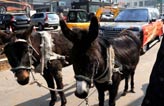Tradition
Pu-er: Yunnan's winning tea
Updated: 2011-03-16 15:45
(cultural-china.com)
Named after a town in Yunnan province, the place where it originated, pu-er tea is a winner of a tea. It is made from rather large leaves that are oxidized twice in a process that imparts a very special earthy flavor. You may know this tea as Bo-lay or Bo-lei tea, both of these are Cantonese pronunciations. In years past, very long ago, this broad-leaf tea was called nuo-shan and it came from a plant that may be related to pre-glacier trees. That Quingmao tea tree, as it is called, is in the family of Camellia or tea plants. It has long ovine-shaped leaves and grows mainly in the highlands in and near Xishanghanna along the Lancanjiang River in the southwestern region of China.
 |
One tale about Pu-er tea tells that Kublai Khan's troops introduced this earthy tea to the rest of China. The veracity of this is questionable. Some say that a Chinese emperor was first to introduce this variety of tea to the west. He sent some to the king of England in 1806. One thing that is guaranteed is that in 1986, Pu-er tea garnered an international award at a fair in Barcelona, Spain; so it truly is a winner.
Pu-er tea is considered a mild tea. Those leaves with a light coating of mold are considered the best. Traditional medicine practitioners recommend the tea to relieve indigestion and diarrhea and to reduce cholesterol. These are only some of the medicinal effects attributed to this tea. There are many others.
Popular since Tang Dynasty times (618 - 907 CE), this tea is mistakenly spoken of as a black tea. Professionals understand why, because it is semi-fermented twice and this process is done longer than most oolong or semi-fermented teas, close to the cusp of what is done for black teas. Several call teas that are not quite black, as is pu-er, a 'Formosa oolong.' Tea made this way keeps its flavor through many infusions, more than almost all other teas. That, too, is a winner.
 |
One thing to note about pu-er tea is that it is the only tea the Chinese like to age. Another notable fact is that they drink it with the same respect Westerners give to a fine wine that is well-aged. A third is that this is tea afficionados like to consume this tea in a leisurely fashion and after a extremely good dinner.
Should you like to so indulge, as several of us did a few years ago in Toronto at the five-star Lai Wah Heen restaurant in the Metropolitan Hotel, buy the very best. We ordered a pot of pu-er for the table at a cost of forty-eight dollars. There were ten to enjoy it and the pot抯 many refills throughout the dinner. Some at the table gulped, but they calmed down when told it only cost about the same price per person as a decent cup of coffee, and lots less than a decent glass of wine. And, we were to have not one but many cups full. Why was this particular one costing so much? Ordered, was a vintage forty-year-old pu-er to accompany a very fine dinner.
Compatriots at the table thought heads had turned to putty when with it was ordered individual bowls of shark's fin soup costing more than ten times that per person. After drinking the first cup of tea, they questioned their sanity and ours. Two infusions later, they were praising the decision, and by the seventh pot of tea, they deemed it phenomenal. For the first time, those new to this aged tea began touting its praises, even touting mine for ordering it.
 |
Unusual among teas, pu-er teas are fermented (but the technical term is really 'oxidized') as a white tea or green one, or they are semi-oxidized and called an 'oolong' tea. That is the kind we had at that dinner. They can also be fully oxidized and be a black tea. Except for the oolong variety, the others are rare and often not good. The very best leaves are usually prepared as an oolong tea. Emperor Zhong of the Song Dynasty (960 - 1279 CE) learned how great this tea was when he ordered his steamed; he used only the buds with hair on them and said that was the best.
Pu-er is versatile in other ways. Some like it mixed with chrysanthemum tea. That is called gupa cha. Made with white tea as the Emperor had it, it is called pu show. Pressed into a bowl shape, as are many other fine teas, it is called tou cha. And as a seven layer cake-tea, it is called bing cha. Made into balls, it is called tuan cha, and in a rectangular cake, it is fang cha.
No matter the shape, be sure to learn how long the tea has been set aside and properly aged. Teabags of pu-er found in a Chinatown supermarket were labeled as two-years old, others said 'five-years-old,' and some had no age. They tasted less good than either of the others. Do not expect the broken leaf teabag types to taste anywhere as good as the longer aged whole leaf varieties; but they are better than some other teas, particularly by the third and fourth infusion.
When making your tea, except for the white or green renditions, be sure the water is at a rolling boil. Most formosa oolong and black teas need water that high, past when they just start to boil. Green teas brew better at thirty degrees lower than that. And, if you want to make the very best tea eggs, use a pu-er tea, aged from two to five years.
If you want to emulate the French in their tea-drinking, as in many other food behaviors, do drink aged pu-er tea. About one-quarter of all tea consumed in France is pu-er tea. Mr. Twining, one of England's favorite tea packers, has a fine new pu-er tea. The first tea brought to England in 1712 was a pakho or 'pekoe' tea. Not the pekoe of today, the tea then was white-haired tea, the kind loved by the Emperors of China. Today the English also import lots of pu-er tea.
Researchers at Xiyuan Hospital and others at the Beijing Academy of Traditional Medicine have been going through old records. They report that in the Qing dynasty (1644 - 1911 CE), pu-er tea leaves and medicinal herbs were decocted together. Called 'Elixir Tea' and recorded in the Secret Recipes of Pills, Powders, Ointments and Pellets of Chinese Medicine in the Imperial Hospital. A recipe for it appears eight times in the Records of Pulse Conditions of Concubine Ying of Emperor Jiaqing. Medicinals using pu-er tea during Qing court times (1644 - 1911 CE) were mixed with purple leaves of perilla and grass-leaf sweetflags. Also included were the rhizome of water-plantain and Chinese hawthorn slices, among other things.
E-paper

Rise and shine
The Chinese solar energy industry is heating up following recent setbacks in the nuclear sector
Preview of the coming issue
Bombs aim for regime change
CSI, with a twist
Specials

Donkey-powered Land Rover
Two donkeys pull a broken-down Land Rover in Shenyang, Liaoning province.

China Fashion Week
Models present creations for the Hosa Swimwear Trend Press Conference 2011.

Peony express
Growers of china's unofficial national flower are reaching out to europe for help
